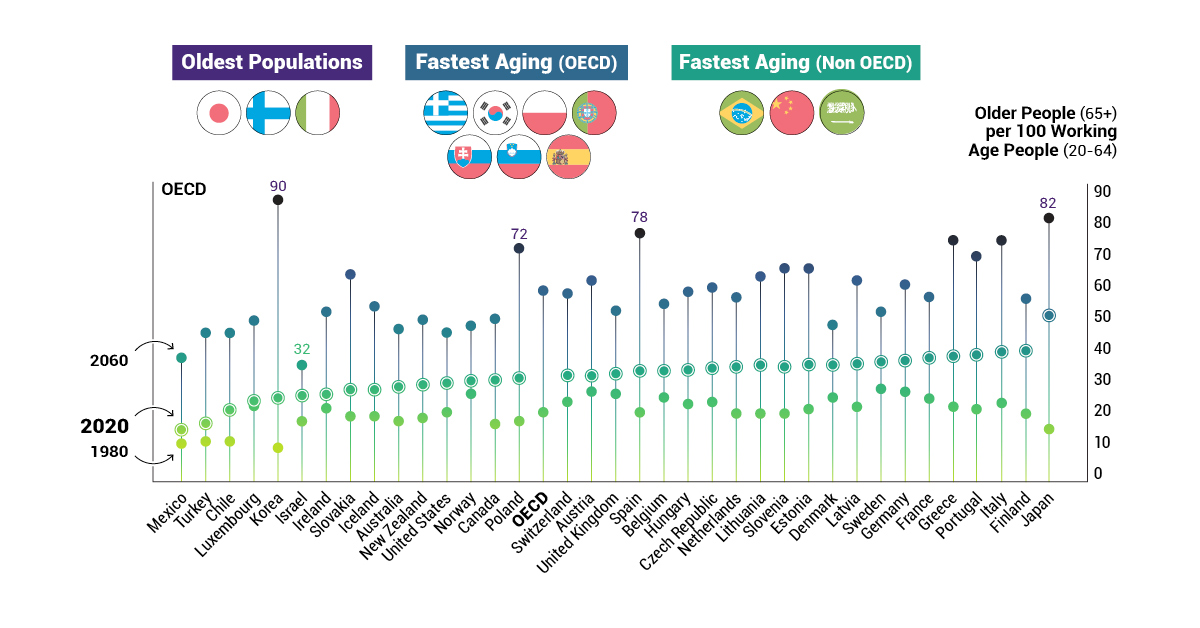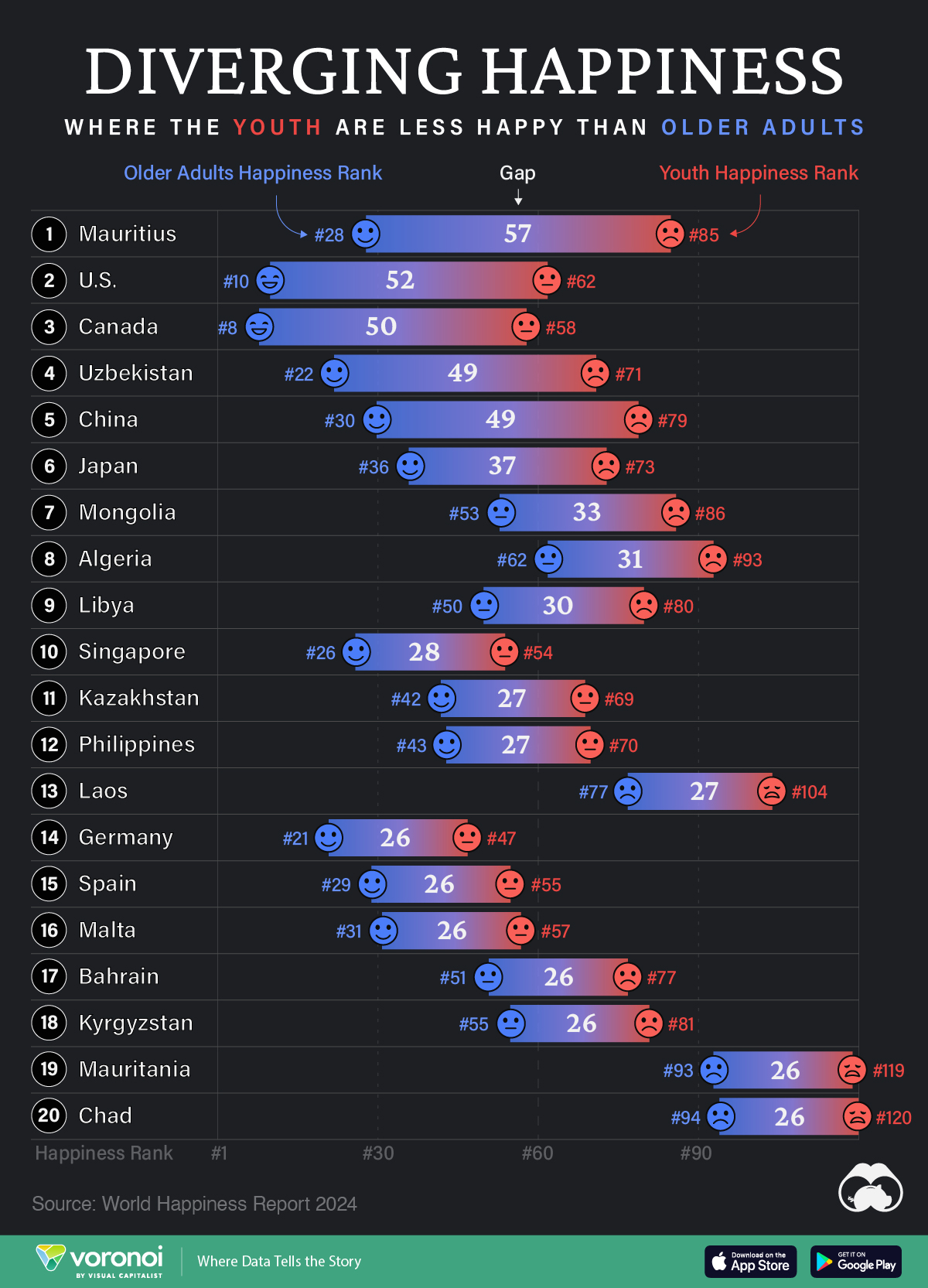Demographics
The Problem of an Aging Global Population, Shown by Country
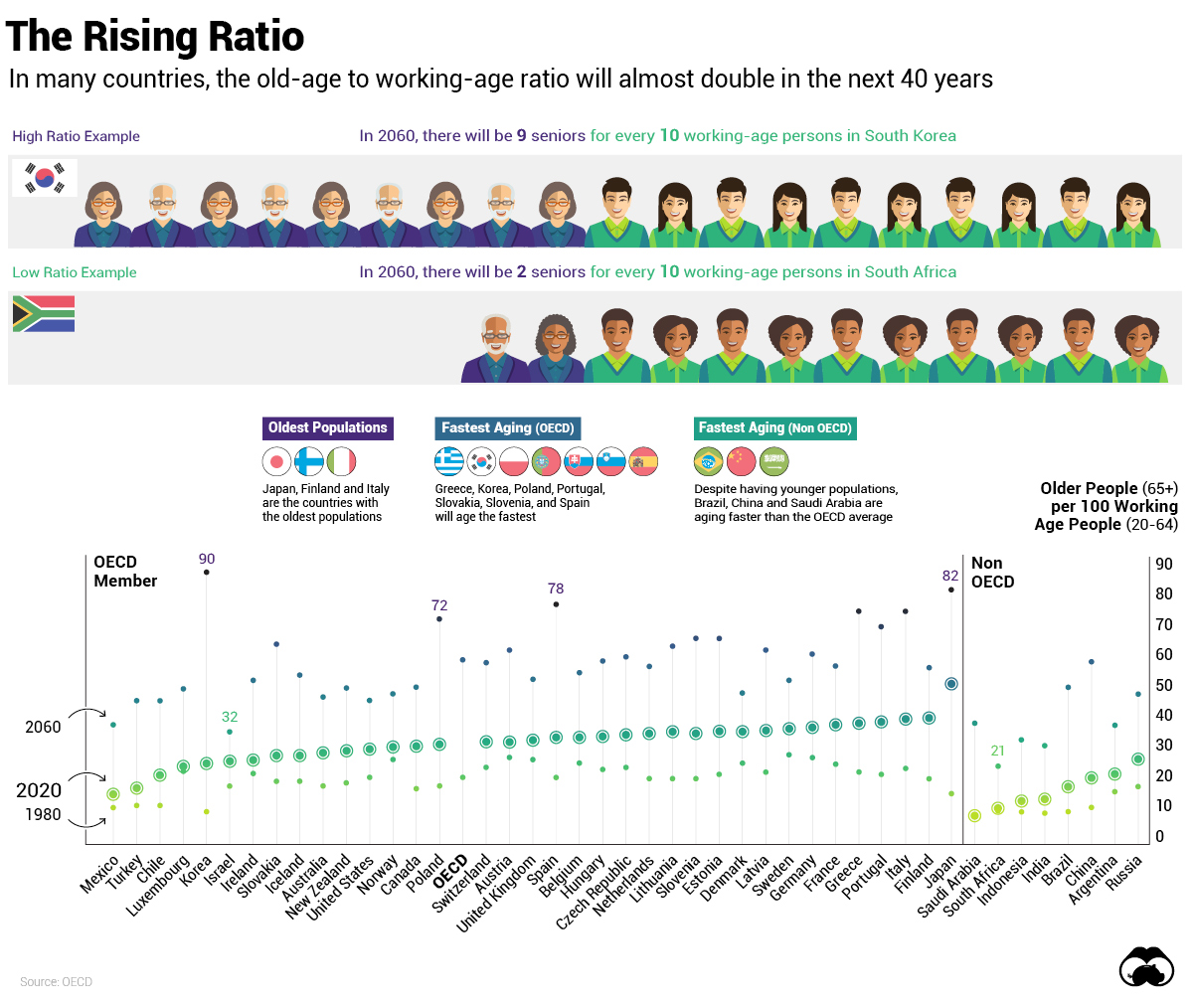
The Implications of an Aging Population
The world is experiencing a seismic demographic shift—and no country is immune to the consequences.
While increasing life expectancy and declining birth rates are considered major achievements in modern science and healthcare, they will have a significant impact on future generations.
Today’s graphic relies on OECD data to demonstrate how the old-age to working-age ratio will change by 2060, highlighting some of the world’s fastest aging countries.
The Demographic Debacle
By 2050, there will be 10 billion people on earth, compared to 7.7 billion today—and many of them will be living longer. As a result, the number of elderly people per 100 working-age people will nearly triple—from 20 in 1980, to 58 in 2060.
Populations are getting older in all OECD countries, yet there are clear differences in the pace of aging. For instance, Japan holds the title for having the oldest population, with ⅓ of its citizens already over the age of 65. By 2030, the country’s workforce is expected to fall by 8 million—leading to a major potential labor shortage.
In another example, while South Korea currently boasts a younger than average population, it will age rapidly and end up with the highest old-to-young ratio among developed countries.
A Declining Workforce
Globally, the working-age population will see a 10% decrease by 2060. It will fall the most drastically by 35% or more in Greece, Japan, Korea, Latvia, Lithuania, and Poland. On the other end of the scale, it will increase by more than 20% in Australia, Mexico, and Israel.
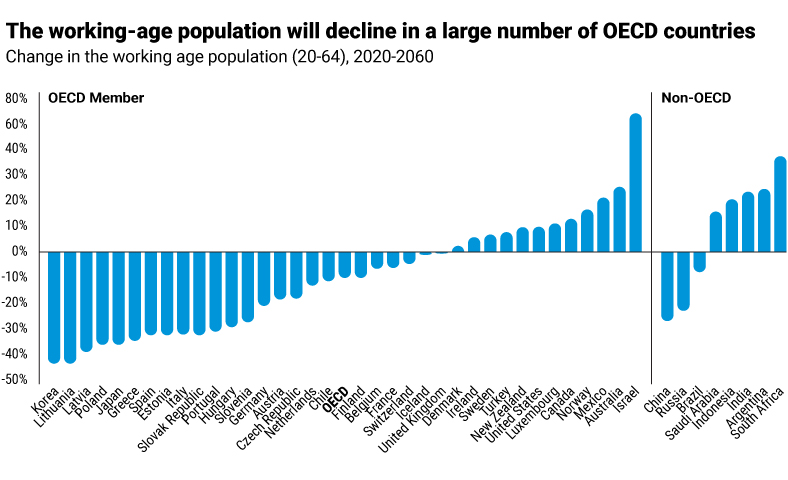
Israel’s notably higher increase of 67% is due to the country’s high fertility rate, which is comparable to “baby boom” numbers seen in the U.S. following the second World War.
As countries prepare for the coming decades, workforce shortages are just one of the impacts of aging populations already being felt.
Managing the Risks
There are many other social and economic risks that we can come to expect as the global population continues to age:
- The Squeezed Middle: With more people claiming pension benefits but less people paying income taxes, the shrinking workforce may be forced to pay higher taxes.
- Rising Healthcare Costs: Longer lives do not necessarily mean healthier lives, with those over 65 more likely to have at least one chronic disease and require expensive, long-term care.
- Economic Slowdown: Changing workforces may lead capital to flow away from rapidly aging countries to younger countries, shifting the global distribution of economic power.
The strain on pension systems is perhaps the most evident sign of a drastically aging population. Although the average retirement age is gradually increasing in many countries, people are saving insufficiently for their increased life span—resulting in an estimated $400 trillion deficit by 2050.
Pensions Under Pressure
A pension is promised, but not necessarily guaranteed. Any changes made to existing government programs can alter the lives of future retirees entirely—but effective pension reforms that lessen the growing deficit are required urgently.
Towards a Better System
Certain countries are making great strides towards more sustainable pension systems, and the Global Pension Index suggests initiatives that governments can take into consideration, such as:
- Continuing to increase the age of retirement
- Increasing the level of savings—both inside and outside pension funds
- Increasing the coverage of private pensions across the labor force, including self-employed and contract employees, to provide improved integration between various pillars
- Preserving retirement funds by limiting the access to benefits before the retirement age
- Increasing the trust and confidence of all stakeholders by improving transparency of pension plans
Although 59% of employees are expecting to continue earning well into their retirement years, providing people with better incentives and options to make working at an older age easier could be crucial for ensuring continued economic growth.
Live Long and Prosper
As 2020 marks the beginning of the Decade of Healthy Ageing, the world is undoubtedly entering a pivotal period.
Countries all over the world face tremendous pressure to effectively manage their aging populations, but preparing for this demographic shift early will contribute to the economic advancement of countries, and allow populations—both young and old—to live long and prosper.
Demographics
Ranked: Countries Where Youth are the Most Unhappy, Relative to Older Generations
Conventional wisdom says that young adults (those below 30) tend to be the happiest demographic—but this is not true for these countries.
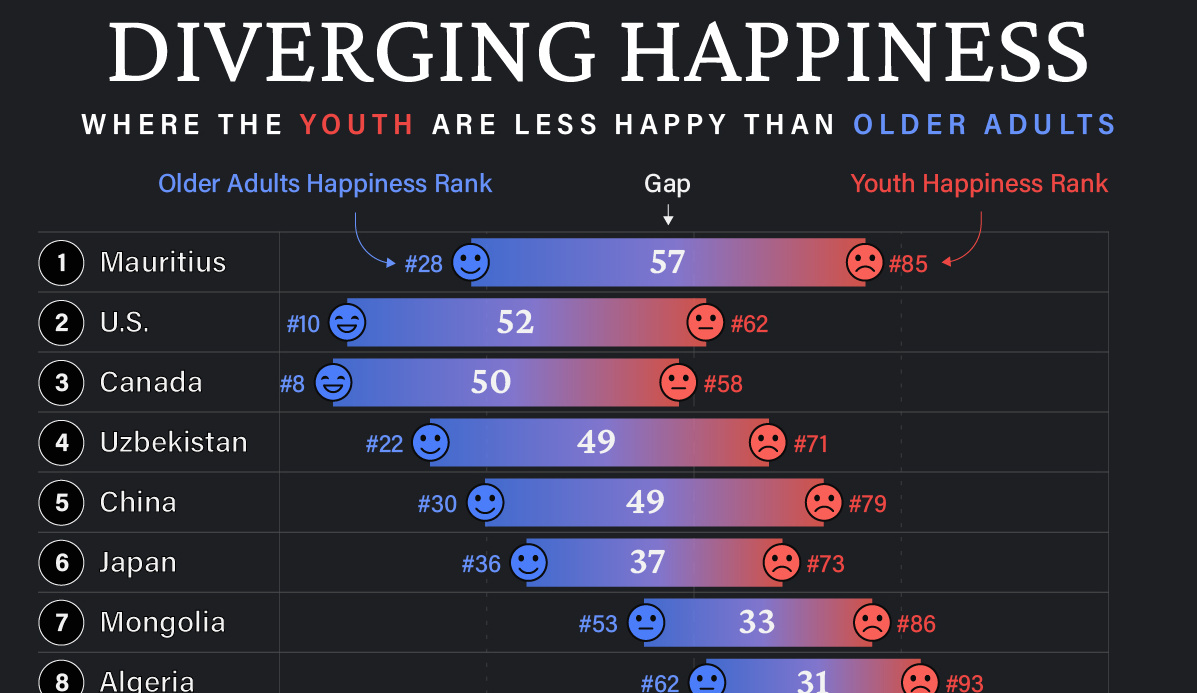
Countries with the Biggest Happiness Gaps Between Generations
This was originally posted on our Voronoi app. Download the app for free on iOS or Android and discover incredible data-driven charts from a variety of trusted sources.
“They say a person needs just three things to be truly happy in this world: someone to love, something to do, and something to hope for.” — Tom Bodett
Measuring happiness is tricky business, more so when taking into account how different regions, cultures, and faiths define it. Nevertheless, the World Happiness Report attempts to distill being happy into a single score out of 10, and then ranks countries by their average score.
We’ve visualized the high-level findings from the latest happiness report in this series of maps. However, the report also dives deeper into other significant trends in the data, such as a growing disparity in happiness between age groups within countries themselves.
In the chart above, we list countries by the biggest gaps in happiness ranks between young adults (<30) and older adults (60+). A higher number indicates a larger gap, and that the youth are far unhappier than their older counterparts.
Where are Youth Unhappier than Older Adults?
Mauritius ranks first on this list, with a massive 57 place gap between older adult and youth happiness. The 1.26 million-inhabited island nation briefly reached high income status in 2020, but the pandemic hit hard, hurting its key tourism sector, and affecting jobs.
The country’s youth unemployment rate spiked to close to 25% that year, but has since been on the decline. Like residents on many similarly-populated islands, the younger demographic often moves abroad in search of more opportunities.
| Rank | Country | Youth Happiness Rank | Older Adult Happiness Rank | Happiness Gap |
|---|---|---|---|---|
| 1 | 🇲🇺 Mauritius | 85 | 28 | 57 |
| 2 | 🇺🇸 U.S. | 62 | 10 | 52 |
| 3 | 🇨🇦 Canada | 58 | 8 | 50 |
| 4 | 🇺🇿 Uzbekistan | 71 | 22 | 49 |
| 5 | 🇨🇳 China | 79 | 30 | 49 |
| 6 | 🇯🇵 Japan | 73 | 36 | 37 |
| 7 | 🇲🇳 Mongolia | 86 | 53 | 33 |
| 8 | 🇩🇿 Algeria | 93 | 62 | 31 |
| 9 | 🇱🇾 Libya | 80 | 50 | 30 |
| 10 | 🇸🇬 Singapore | 54 | 26 | 28 |
| 11 | 🇰🇿 Kazakhstan | 69 | 42 | 27 |
| 12 | 🇵🇭 Philippines | 70 | 43 | 27 |
| 13 | 🇱🇦 Laos | 104 | 77 | 27 |
| 14 | 🇩🇪 Germany | 47 | 21 | 26 |
| 15 | 🇪🇸 Spain | 55 | 29 | 26 |
| 16 | 🇲🇹 Malta | 57 | 31 | 26 |
| 17 | 🇧🇭 Bahrain | 77 | 51 | 26 |
| 18 | 🇰🇬 Kyrgyzstan | 81 | 55 | 26 |
| 19 | 🇲🇷 Mauritania | 119 | 93 | 26 |
| 20 | 🇹🇩 Chad | 120 | 94 | 26 |
Conventional wisdom says, and data somewhat correlates, that young adults (those below 30) tend to be the happiest demographic. Happiness then decreases through middle age and starts increasing around 60. However, the above countries are digressing from the pattern, with older generations being much happier than young adults.
That older generations are happier, by itself, is not a bad thing. However, that younger adults are so much unhappier in the same country can point to several unique stresses that those aged below 30 are facing.
For example, in the U.S. and Canada—both near the top of this list—many young adults feel like they have been priced out of owning a home: a once key metric of success.
Climate anxieties are also high, with worries about the future of the world they’ll inhabit. Finally, persistent economic inequities are also weighing on the younger generation, with many in that cohort feeling like they will never be able to afford to retire.
All of this comes alongside a rising loneliness epidemic, where those aged 18–25 report much higher rates of loneliness than the general population.
Source: The World Happiness Report which leverages data from the Gallup World Poll.
Methodology: A nationally representative group of approximately 1,000 people per country are asked to evaluate their life on a scale of 0–10. Scores are averaged across generations per country over three years. Countries are ranked by their scores out of 10.
-

 United States6 days ago
United States6 days agoMapped: Countries Where Recreational Cannabis is Legal
-

 Healthcare2 weeks ago
Healthcare2 weeks agoLife Expectancy by Region (1950-2050F)
-

 Markets2 weeks ago
Markets2 weeks agoThe Growth of a $1,000 Equity Investment, by Stock Market
-

 Markets2 weeks ago
Markets2 weeks agoMapped: Europe’s GDP Per Capita, by Country
-

 Money2 weeks ago
Money2 weeks agoCharted: What Frustrates Americans About the Tax System
-

 Technology2 weeks ago
Technology2 weeks agoCountries With the Highest Rates of Crypto Ownership
-

 Mining2 weeks ago
Mining2 weeks agoWhere the World’s Aluminum is Smelted, by Country
-

 Personal Finance1 week ago
Personal Finance1 week agoVisualizing the Tax Burden of Every U.S. State

